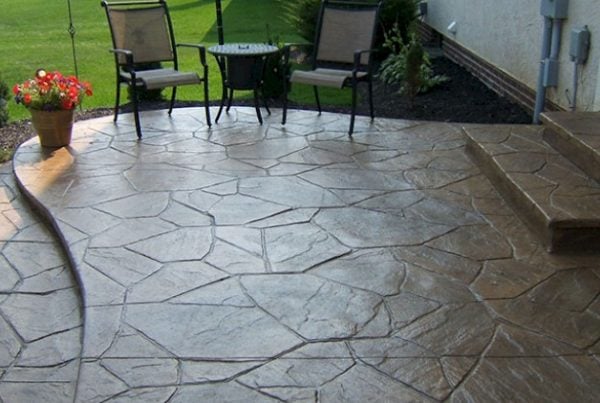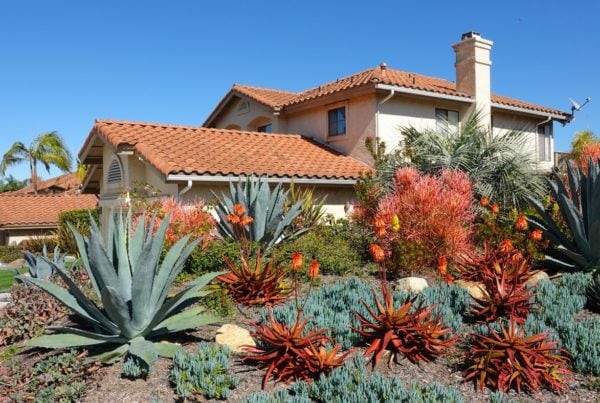When properly applied, landscaping fabric can smother weed growth and improve the overall aesthetic of your outdoor spaces. Read on to learn the proper steps for applying landscaping fabric, so you can enjoy a beautiful, low-maintenance garden.
1. Measure.
First, you will need to determine how much fabric and how many landscaping staples you need to complete your project. Measure the area and write your numbers down. You can then take this information with you to the store and read the product labels on available landscaping fabric to determine how much you need to buy.
2. Pull weeds.
Using a garden hoe, pull up any weeds that are currently growing in the spot where you plan to apply your landscaping fabric. Be sure to remove every part of each weed, including the roots. You may need to get down on your knees and hack out stubborn weeds using a hand trowel.
3. Apply soil amendments.
If you plan to apply manure, compost or fertilizer, you will need to do so before you apply your fabric. Depending on the type of vegetation you will be planting, you may also want to put down bone meal or some other special fertilizer. It’s also generally a good idea to get pH measurements to make sure the soil is able to support your plants.
4. Level the soil.
Use a good bow rake to scrape away any uprooted weeds, twigs, rocks and debris that might tear the landscaping fabric. Then rake the soil until it is relatively flat and smooth. Remove any large stones and other obstructions that might get in the way as you are trying to apply your fabric.
5. Apply the landscaping fabric.
Roll out your fabric atop the whole area where you hope to prevent weed growth. Most products are designed to have the fuzzy side face down, but you should read the product label to make sure you are applying the fabric right side up.
Carefully cut away any excess fabric using a utility knife or sharp pair of scissors. Ideally, you should leave two or three extra inches of excess fabric around the edges of the garden bed.
If you need to use multiple sheets of landscaping fabric to cover a large area, overlap each section by at least 6 to 12 inches. Insufficient overlapping can give weeds a foothold to grow and start needling their way through the seams.
 6. Secure the fabric.
6. Secure the fabric.
Apply landscaping staples to keep the fabric from blowing up. Use a hammer or rubber mallet to gently tap the staples firmly into the soil.
Use a generous amount of staples to ensure that the fabric will remain in place in harsh weather. In most instances, you should use at least one staple every 8 to 12 inches along every edge of the fabric and along any seams where separate pieces join.
7. Plant.
Using your utility knife, slice a small “X” in the landscaping cloth wherever you plan to place a flower, shrub or other plants. Limit the size of the cut so it will barely accommodate the root ball.
Pull back the flaps of fabric so you can gently dig a hole and place the plant. Fill the hole with soil and gently pack it down to eliminate air pockets.
When you finish planting, firmly secure the fabric around the base of the plant. Leave no room for weeds to break through.
8. Apply mulch.
Once the fabric is securely fastened and the plants are in place, apply a 2-3 inch layer of mulch. This will add a pleasant aesthetic while blocking UV rays and keeping the fabric firmly in place. It can also help prevent moisture loss and keep the underlying soil nice and moist to support root growth.
You can use any kind of organic or inorganic mulch, from bark to wood chips to gravel, river rocks and even rubber.
9. Maintain your garden.
While landscaping fabric can drastically cut down on garden maintenance, you will still have some responsibilities. Weed seeds can still germinate on top of the cloth within blown-in dirt and decomposing organic mulch. You will also need to reapply mulch from time to time as it decays or blows away in storms.
If you use rubber, river rocks or some other types of inorganic mulch, you may need to remove it occasionally and rinse away dirt or debris.
While landscaping fabric can take the headache out of maintaining gardens, it takes considerable experience and know-how to create exceptional outdoor spaces. If you really want your outdoor areas to shine, it’s best to work with a reputable landscaping company that knows how to bring your vision into the real world.
At RMPS Landscaping in Castle Rock, we provide a complete spectrum of expert landscaping services, from water features and hardscaping, trees, outdoor lighting, terracing, sod and total landscape renovations. Contact our attentive team to learn how we can help turn your boldest vision into reality.





